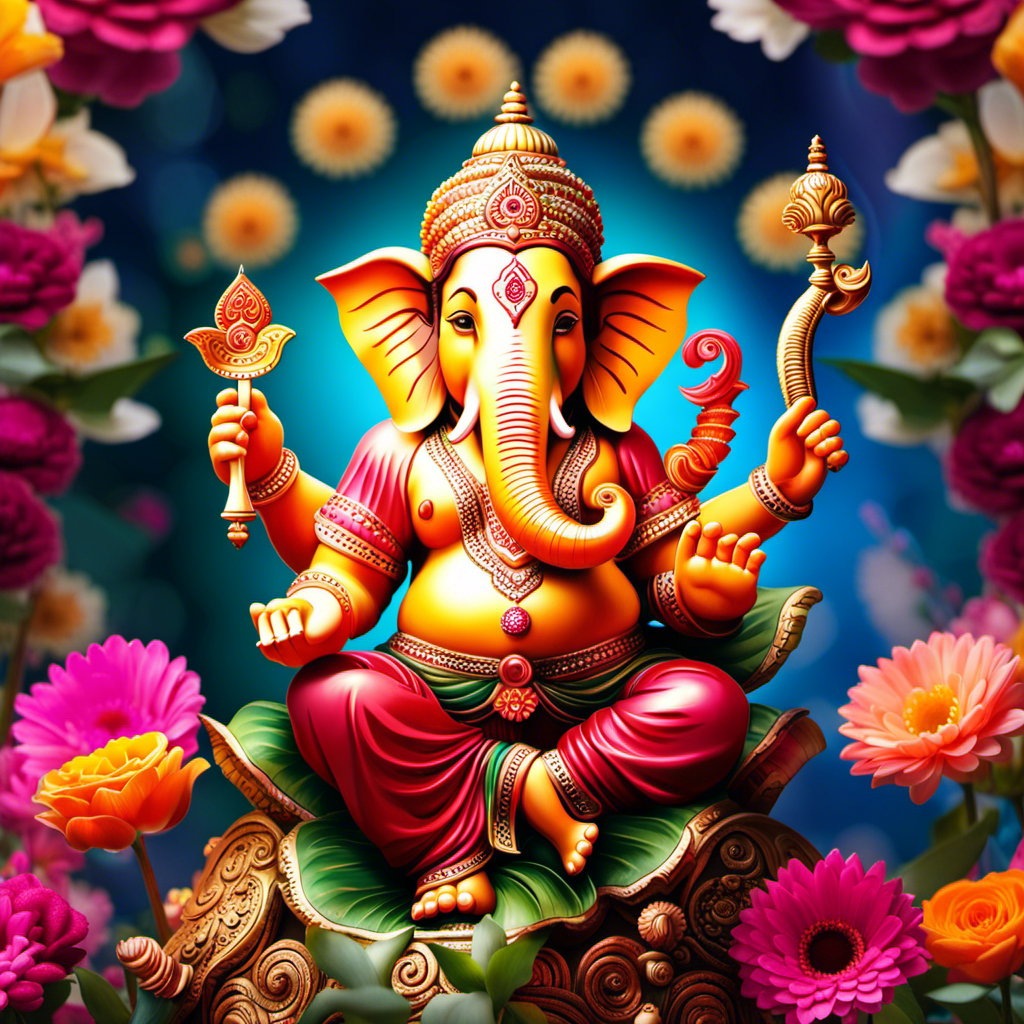Hey there! Want to dive into the fascinating world of Ganges River fun facts?
Brace yourself for an immersive journey through its captivating history, sacred rituals, and breathtaking biodiversity.
From the ancient tales that surround it to the modern-day infrastructure that spans its length, this majestic river has left an indelible mark on Indian literature and art.
So get ready to embark on a truly unforgettable adventure as we uncover the hidden wonders of the sacred Ganges together.
Let’s dive in!
Key Takeaways
- The Ganges River is considered the holiest river in Hinduism and holds immense religious significance.
- The Ganges River is about 1,569 miles long, making it one of the longest rivers in the world, and has been a crucial trade route for centuries.
- The Ganges River is home to threatened species, and conservation efforts are crucial for maintaining the ecosystem’s balance.
- The Ganges River facilitates trade and commerce, creates job opportunities, and contributes to the overall prosperity of the region.
The Holy River
The Ganges River is considered the holiest river in Hinduism. It holds a special place in the hearts of millions of believers, who flock to its sacred banks to perform various rituals and seek spiritual significance.
The river’s waters are believed to possess purifying properties, capable of cleansing one’s sins and granting salvation. The Ganges is not just a physical entity; it embodies a divine presence that connects people to their religious roots and fosters a sense of belonging.
Countless devotees immerse themselves in its holy waters, offering prayers and performing sacred ceremonies. This ancient tradition has been passed down through generations, creating a profound spiritual connection between individuals and the divine energy that flows within the Ganges River.
Length and Location
Did you know that the Ganges is about 1,569 miles long and flows through India and Bangladesh? This magnificent river holds many fascinating secrets that will ignite your sense of wonder. Here are some fun facts to pique your interest:
- The Ganges River is considered sacred by Hindus, who believe that bathing in its waters purifies the soul.
- Its length makes it one of the longest rivers in the world!
- The Ganges has been a crucial trade route for centuries, contributing to the growth of commerce in the region.
- This majestic river has inspired countless works of literature and art, leaving an indelible mark on Indian culture.
- From ancient times to today, people have found solace and belonging along its banks, creating vibrant communities.
The Ganges River’s length and location have not only shaped trade and commerce but also influenced Indian literature and art. Explore its wonders and embark on a journey like no other!
Sacred Bathing Rituals
Bathing in its waters purifies your soul, making it a sacred ritual for Hindus. The Ganges River holds immense religious significance as it is believed to be the earthly manifestation of the goddess Ganga.
For centuries, millions of devotees have flocked to its banks to partake in this ancient tradition. By immersing yourself in the holy waters, you wash away impurities and sins, and emerge spiritually renewed.
This sacred practice not only cleanses your body but also connects you with the divine energy that flows through the river’s currents. As you immerse yourself, feel the power of this age-old tradition enveloping you, creating a sense of belonging and oneness with something greater than yourself.
Let the sacred traditions of the Ganges guide you towards spiritual awakening and inner peace.
Historical Significance
Imagine a world where ancient civilizations shaped the very essence of our present cultural landscape. The role they played in shaping our beliefs, traditions, and values is profound and continues to impact us today.
From their groundbreaking advancements in science and technology to their rich artistic expressions, these ancient civilizations have left an indelible mark on our collective consciousness.
Cultural Impact Today
The Ganges River still holds immense cultural significance today, with pilgrims flocking to its banks to partake in traditional rituals. The river is not only a physical entity but also a symbol of spirituality and purity. People from different cultures come together to celebrate their shared beliefs and practices along the sacred river.
| Cultural Traditions | Religious Practices |
|---|---|
| Festivals | Bathing Rituals |
| Music and Dance | Prayer Ceremonies |
| Artistic Expressions | Offerings and Offerings |
Cultural traditions surrounding the Ganges River include vibrant festivals, where people come together to sing, dance, and express their joy. These festivities create a sense of belonging and unity among the participants. Additionally, music and dance play an integral role in religious practices along the Ganges River. Melodies fill the air as devotees offer prayers and perform ceremonies to seek blessings and purification.
Artistic expressions such as paintings, sculptures, and poetry are also deeply intertwined with the cultural fabric of this region. Artists use their creativity to portray the divine beauty of the river and capture its spiritual essence.
Participating in bathing rituals is another significant aspect of religious practices along the Ganges River. Devotees believe that immersing themselves in its holy waters can cleanse them of sins and bring them closer to enlightenment.
Overall, the cultural impact of the Ganges River is profound, fostering a sense of belonging through shared traditions, beliefs, artistic expressions, and religious practices. It continues to inspire millions around the world with its rich heritage that transcends boundaries.
Role in Ancient Civilizations
When you explore the role of the Ganges River in ancient civilizations, you’ll discover its significance as a lifeline for agricultural development and trade routes.
The river played a vital role in fostering the growth of agriculture, providing fertile land and water for irrigation. Ancient societies along its banks developed innovative irrigation techniques to maximize crop yields and sustain their communities. This enabled them to cultivate various crops, such as rice, wheat, and barley, which formed the backbone of their economies.
The Ganges River not only served as a source of livelihood but also facilitated trade between different regions. It became a bustling route for transporting goods, connecting diverse cultures and creating a sense of belonging among these ancient civilizations.
The river’s role in agriculture and trade truly shaped the destiny of those who called it home.
Biodiversity and Conservation
Imagine a world where the majestic Ganges River is devoid of its rich biodiversity, where threatened species such as the Gangetic dolphin and the Gharial crocodile no longer grace its waters. This is a reality that we must strive to prevent, for the conservation efforts in the Ganges are crucial in maintaining the delicate balance of its ecosystem.
Biodiversity plays a vital role not only in preserving the beauty and uniqueness of this sacred river, but also in ensuring a sustainable future for all lifeforms dependent on it.
Threatened Species in Ganges
Did you know that there are several threatened species in the Ganges River? The conservation efforts to protect these unique creatures and their habitats are crucial for the future of this majestic river. Take a look at the table below to get a glimpse of some of these endangered species:
| Species | Status |
|---|---|
| Ganges River Dolphin | Critically Endangered |
| Indian Skimmer | Endangered |
| Gharial | Critically Endangered |
| Smooth-coated Otter | Vulnerable |
| Red-headed Vulture | Critically Endangered |
Each of these species plays a vital role in maintaining the delicate balance of the ecosystem. Through innovative conservation efforts, we can ensure their survival and preserve the beauty and diversity of the Ganges River for generations to come. Join us in our mission to protect these threatened species and create a world where they can thrive alongside us, fostering a sense of belonging and harmony with nature.
Conservation Efforts in Ganges
Conservation efforts in the Ganges are crucial for protecting endangered species and preserving the river’s delicate ecosystem. The Ganges is not just a river; it is a lifeline, a source of spirituality, and a symbol of cultural heritage for millions. But with increasing human activity and pollution, its environmental impact has become concerning. The time to act is now, as our actions today will shape the future of this sacred river.
By implementing effective conservation efforts, we can ensure the survival of endangered species that call the Ganges home. From the elusive Ganges River Dolphin to the critically endangered Gharial crocodile, these remarkable creatures rely on clean water and undisturbed habitats.
Moreover, conserving the Ganges means safeguarding its fragile ecosystem. By reducing pollution levels and promoting sustainable practices, we can maintain a healthy balance between humans and nature. This is not just about preserving a beautiful landscape; it’s about creating harmony between us and our environment.
Together, we have the power to make a difference. Every action counts – from simple steps like reducing plastic waste to supporting organizations dedicated to restoring the health of this magnificent river. Let us come together as stewards of our planet and protect this invaluable natural treasure for generations to come.
Importance of Biodiversity
Now that you understand the conservation efforts being made to protect the Ganges River, let’s delve into the importance of biodiversity in maintaining ecosystem balance. Biodiversity refers to the variety of plant and animal species within an ecosystem. It plays a crucial role in sustaining life on Earth by providing essential services such as pollination, nutrient cycling, and pest control.
To further illustrate this point, let’s take a look at the following table:
| Benefits of Biodiversity | Examples |
|---|---|
| Ecosystem Stability | Forests regulating climate by absorbing carbon dioxide |
| Food Security | Crop diversity ensuring resilience against diseases |
| Medicinal Resources | Plants used for developing lifesaving drugs |
| Cultural Significance | Traditional practices and spiritual beliefs tied to species |
As you can see, conserving biodiversity is not just about protecting individual species; it is about safeguarding our planet’s delicate balance. By valuing and preserving diverse ecosystems, we can ensure a sustainable future for all living beings who call the Ganges River their home.
Cultural Festivals and Celebrations
You can’t miss out on the vibrant cultural festivals and celebrations happening along the Ganges River. Immerse yourself in the rich tapestry of cultural traditions and witness the beauty of traditional attire worn by locals as they come together to celebrate their heritage.
Here are some remarkable experiences you shouldn’t overlook:
- Colorful processions: Join in the lively parades where people dance, sing, and play music while carrying ornate idols of deities through the streets.
- Traditional performances: Be captivated by mesmerizing folk dances, classical music concerts, and theatrical performances that showcase India’s diverse cultural expressions.
- Ritualistic ceremonies: Witness ancient rituals taking place along the riverbanks, where devotees offer prayers and light candles as a symbol of devotion.
- Delicious feasts: Savor authentic regional cuisine at food stalls lining festival grounds, offering a mouthwatering array of flavors that will leave you craving for more.
These enchanting festivals will make you feel like you belong to this vibrant community, connecting with centuries-old customs and fostering a sense of unity among participants.
So come prepared to immerse yourself in these unforgettable celebrations!
Economic Importance
Imagine a world where the flow of trade and commerce along the Ganges River is thriving, creating boundless opportunities for job seekers.
Picture yourself as an entrepreneur, harnessing the abundant natural resources found along its banks to fuel your business ventures.
This discussion will delve into the economic importance of the Ganges, exploring how it can be a catalyst for growth and prosperity in the region.
Trade and Commerce
If you’re interested in trade and commerce, the Ganges River has played a significant role in facilitating economic activities for centuries. This majestic river has served as one of the most crucial trade routes in history, connecting various regions and fostering a vibrant exchange of goods and ideas. In fact, the Ganges River has witnessed countless historical trades that have shaped civilizations and propelled economic growth. To give you a glimpse of its influence, here’s a table showcasing some fascinating examples:
| Historical Trade | Goods Traded |
|---|---|
| Silk Route | Silk, spices, precious gems |
| Indus Valley Civilization | Textiles, pottery |
| Mughal Empire | Agricultural products |
| British Raj | Tea, cotton |
As you can see, these trades encompassed a wide range of valuable items that traveled through the Ganges River network. Such rich history demonstrates how this iconic river continues to inspire and connect communities around its banks today.
Job Opportunities
The Ganges River has created numerous job opportunities for local communities throughout history. Its economic impact cannot be overstated, as it has provided livelihoods and sustained the growth of towns and cities along its banks. Here are four ways in which the Ganges River has transformed lives and fostered a sense of belonging:
- Fishing: The river is home to a rich variety of fish, providing employment for thousands who rely on fishing as their primary source of income.
- Agriculture: The fertile soil around the river allows for abundant agricultural production, creating jobs for farmers and laborers.
- Tourism: The Ganges River attracts millions of tourists each year, leading to the development of hotels, restaurants, and other hospitality businesses that provide employment opportunities.
- Transportation: The river serves as a major transportation route, supporting jobs in boat manufacturing, navigation services, and cargo transport.
Through these diverse job opportunities, the Ganges River continues to shape the lives of those living alongside it while contributing to the overall prosperity of the region.
Natural Resources
Now that you’ve explored the job opportunities along the Ganges River, let’s dive into another fascinating aspect: its natural resources and their economic impact. The Ganges River is a lifeline for millions of people, providing not only water for drinking and irrigation but also a diverse range of valuable resources.
To help you understand the significance of these natural resources, take a look at the table below:
| Natural Resource | Economic Impact |
|---|---|
| Fish | Major source of income for local fishermen and contributes to regional economy through exports |
| Sand | Used in construction industry, generating employment and driving economic growth |
| Agriculture | Fertile soil along the riverbanks supports agriculture, sustaining livelihoods and boosting food production |
| Hydroelectric power | The river’s strong current powers hydroelectric plants, providing clean energy and contributing to India’s electricity supply |
These natural resources not only meet local needs but also contribute to national economic development. They play a vital role in fostering sustainable growth and creating opportunities for communities along the Ganges River.
Pollution and Environmental Concerns
Despite its religious significance, the Ganges River is facing severe pollution and environmental concerns. But don’t lose hope! There are solutions to combat this pollution and protect this sacred river.
One of the key ways to address this issue is through government regulations. The government can enforce stricter laws and policies to prevent industries from dumping waste into the river. By implementing rigorous monitoring systems, they can ensure that industries comply with these regulations.
Additionally, promoting sustainable practices among communities living along the riverbanks can also make a significant difference. Encouraging proper waste management, reducing plastic usage, and educating people about the importance of protecting their environment will foster a sense of belonging and responsibility towards the Ganges River.
Together, we can restore its purity and preserve it for future generations to cherish.
Mythology and Legends
One interesting aspect of the mythology and legends surrounding the Ganges River is that it is believed to have originated from Lord Shiva’s matted hair. According to mythological tales, when Lord Shiva released the mighty river onto Earth, its powerful waters cascaded down from his locks, creating a divine connection between heaven and earth.
This sacred river holds immense significance in religious beliefs, with millions of people flocking to its banks each year for spiritual cleansing and purification. The Ganges River has become a symbol of belonging for countless devotees who seek solace and renewal in its holy waters.
Its mythical origins and revered status make it a beacon of hope and unity, drawing people together in their shared faith and reverence for this extraordinary natural wonder.
Bridges and Infrastructure
Did you know that the bridges spanning the Ganges River play a crucial role in connecting communities and facilitating transportation across the region?
These magnificent structures are not just concrete and steel, but symbols of progress and unity.
Here are three reasons why bridges construction and transportation infrastructure along the Ganges River are pivotal for the community:
- Enhancing Connectivity: The bridges act as lifelines, linking towns and villages that were once isolated. They enable people to access education, healthcare, and job opportunities easily.
- Boosting Trade: With better connectivity, trade flourishes along the riverbanks. The bridges allow goods to flow seamlessly, stimulating economic growth and creating employment opportunities.
- Fostering Social Cohesion: By bridging physical gaps between communities, these structures promote cultural exchange and understanding among diverse groups of people.
The construction of these bridges is transforming lives by providing vital connections and fostering a sense of belonging in this vibrant region.
River Cruises and Tourism
If you’re planning a trip along the Ganges, river cruises offer a unique opportunity to explore the region’s rich cultural heritage and breathtaking landscapes.
Embark on an unforgettable journey that will immerse you in the vibrant tapestry of India’s spiritual heartland.
As you glide along the sacred waters, witness ancient temples, bustling marketplaces, and traditional rituals that have been carried out for centuries.
Feel a sense of belonging as you connect with locals who call this enchanting river their home.
Let the gentle sway of the boat lull you into a state of tranquility, as each passing moment reveals hidden treasures waiting to be discovered.
Experience the magic of India like never before on these captivating river cruises designed to inspire your wanderlust and create memories that will last a lifetime.
Don’t miss out on this extraordinary opportunity to be part of something truly special in one of the world’s most beloved destinations.
Influence on Indian Literature and Art
Now that you’ve learned about the fascinating river cruises and tourism along the Ganges River, let’s dive deeper into its influence on Indian literature and art. The Ganges holds a profound place in the hearts of Indians, serving as a muse for countless poets, authors, and artists throughout history. Its sacredness and spiritual significance have inspired powerful narratives and evocative imagery that capture the essence of India’s cultural heritage.
To provide you with a visual representation of this impact, here is a table showcasing some notable examples of how the Ganges has influenced literature and art in India:
| Literature | Art |
|---|---|
| “The River Goddess” by Rabindranath Tagore | “Ganga Aarti at Varanasi” by Raja Ravi Varma |
| “River of Smoke” by Amitav Ghosh | “Ganga Ghats” series by MF Husain |
| “The Hungry Tide” by Amitav Ghosh | “Ganges: Sacred Flow” installation by Subodh Gupta |
Through these literary works and artistic creations, the Ganges River continues to weave its magic, leaving an indelible mark on Indian culture. It serves as a source of inspiration for those seeking to understand the soul of this ancient land, fostering a sense of belonging among its people.
Frequently Asked Questions
What Is the Average Temperature of the Ganges River?
The average temperature of the Ganges River is important for the survival of its diverse aquatic life. Understanding this temperature helps us appreciate and protect the river, fostering a sense of belonging to this unique ecosystem.
How Many Species of Fish Can Be Found in the Ganges River?
The Ganges River boasts incredible species diversity, with numerous fish species calling it home. Conservation efforts are crucial in preserving this rich biodiversity. Together, we can ensure the future of these aquatic inhabitants and their vital place in our ecosystem.
Are There Any Restrictions on Swimming in the Ganges River?
There are restrictions on swimming in the Ganges River due to environmental concerns. It is important to be aware of these limitations and consider alternative ways to enjoy the river while respecting its significance.
What Are Some Common Myths or Misconceptions About the Ganges River?
Common misconceptions about the Ganges River include it being dirty and polluted. However, it holds immense cultural importance as a sacred river in Hinduism. Embrace the truth of its significance and belonging to a rich heritage.
What Is the Significance of the Ganges River in Hindu Mythology?
The Ganges River holds immense significance in Hindu mythology, representing purity and divinity. It is also environmentally important, providing water for millions of people and supporting diverse ecosystems.
Conclusion
Congratulations! You have now embarked on a fascinating journey through the majestic Ganges River. Its length and sacred location make it a beacon of spirituality for millions.
The river’s historical significance, biodiversity, and conservation efforts showcase its importance to both nature and mankind. Rich in mythology and legends, the Ganges has inspired countless works of art and literature.
With bridges spanning its waters and river cruises offering breathtaking views, tourism flourishes along its banks. The Ganges is not just a river; it is an emblem of India’s culture, heritage, and resilience.
Let us continue to cherish this lifeline that connects past, present, and future generations in an eternal flow of inspiration.





